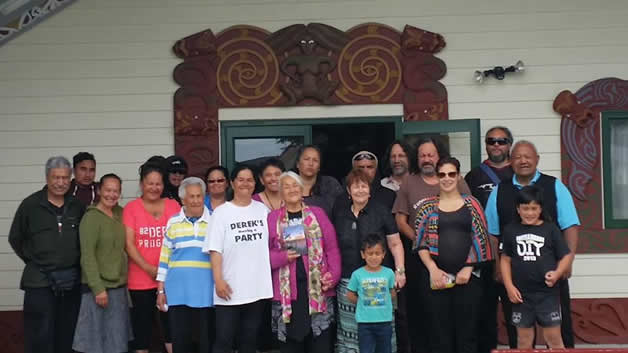Upcoming events
We would like to let whānau know that we have booked Tuahuru Marae in Mahia from 30 January until 1 February 2015.
We are treating this as the dress rehearsal for the Te Matatini pōwhiri. I would like to let as many whānau know in the hope that a few from all our close taurahaere can attend. The ties that bind our hearts.
Please contact me in the evenings by email: [email protected] or on 022 169 6540 if you are interested in attending the waiata wānanga. I am looking for numbers for catering purposes. All for one and one for all. Operating in that manner, there is no failure.
In support of our current kaupapa (Te Matatini pōwhiri), we would like to share this piece written by Julie Ryland, Te Ngāi Tūāhuriri Rūnanga, te whānau Reuben.
On 11 December, she will graduate and she is looking at furthering her knowledge in the field of Māori music and writing next year at the Eastern Institute of Technology in Gisborne. She is a long-standing singer/songwriter, who has travelled extensively working in the music industry. Reggae music is her forte.
Supportive song (waiata tautoko)
The ancient world sings to us every day.
I will pass on the purpose of a supportive song (waiata tautoko) by highlighting the significance of why we sing the supportive song during a Ngāti Kahungunu welcoming ceremony (pōwhiri) and using two interviews I conducted with Ahuriri Houkamau, and Margaret Young (both Ngāti Kahungunu). I can showcase the supportive song as an author of history and teacher for generations and how in modern day, it is still an official part of the Māori people.
The supportive song is sung during a Māori welcome and is sung after each speaker; predominantly men, of the visiting party (manuhiri) and the speaker of the home people (tāngata whenua). Without the speech, the supportive song would not be performed, so they go hand-in-hand with the passing down of knowledge to the next generation. The Māori welcome is also equivalent to a university, the speech and the supportive song are history lessons and exchange information of how Māori lived, loved, died, fought, nurtured and survived. Margaret Young (Per Comm April 23, 2014), spoke about how singing supportive songs was something she had done with her family since childhood, songs passed down to her from her ancestors (tīpuna).
The supportive song enhances the speech and supports what the gathering (hui) is for and in the case of a funeral (tangihanga), it can relate to who and where the deceased person belongs. The supportive song sung would be a song of lament (mōteatea) which could consist of genealogy, love stories, sad moments in the times of our ancestors. According to A.Houkamau (Per Comm May 14, 2014), it would not be appropriate to sing a happy upbeat song at a funeral and you wouldn’t sing a song of lament at a wedding. During the interview, A.Houkamau (Per Comm May 14 2014) spoke about the importance of making the right song choice and not using hymns for this purpose. I have only ever heard hymns sung in homage to God during church. The interviewee also spoke about the focus being on the essence of the song and its significance, not the singer.
Furthermore, the singer will stand beside the speaker, regardless of where he will be standing or, the speaker will sing the song alone. It would not be supportive if those assisting with the singing were to stand in a different area. By standing beside the speaker it is also a sign of being organised, united and orderly.
Ultimately, the purpose of the supportive song is not just a song plucked from the top of your head or a song to bring down the house. It is the truest, most traditional way of being Māori, taught by Māori, to live as Māori. It showcases Māori as being unique and exquisite narrators with its own institution of higher education. Without the speech and the supportive song there is no trace of Māori – but that will never be the case.
References
Houkamo.A. Interview May 12, 2014.
Young.M, Interview April 24, 2014.
Waiata wānanga
We recently held our waiata wānanga at Pukemokimoki Marae and they looked after us like we were royalty – many thanks and gratitude.
After our short lesson from Whaea Pip, we started our day of waiata with a grounding in Papatūānuku rāua ko Rangi. We worked hard all day and Whaea Liz was the man all day, with Maiauna being the wahine. During the day we had two tea breaks, lunch and dinner and we took hold of Ka Karuerue with a passion in an attempt to learn it inside out.
After dinner we ran through the seven songs, which we learnt over and over again. We finished around 9.30pm with a karakia.
We also welcomed Moe Miyazaki, a Japanese visitor to our country. We hosted her the first night as a gesture towards Masashi Yamada, who looked after our iwi in our time of need, so we looked after one of his countrymen in return.
We had a poroporoaki on Sunday after breakfast, before cleaning and packing up. We were able to hand out registration forms and take an iwi photo together.
We are looking forward to our last waiata wānanga next year before we head down home to be a part of the pōwhiri/hākari for Te Matatini 2015 – He Ngākau Aroha, where we too can thank Aotearoa for all of the assistance they have given our iwi.
To whānau, may you all have a very safe and prosperous summer and enjoy each other’s company, love, hospitality and unity. Te atua manaaki ki a koutou katoa.
